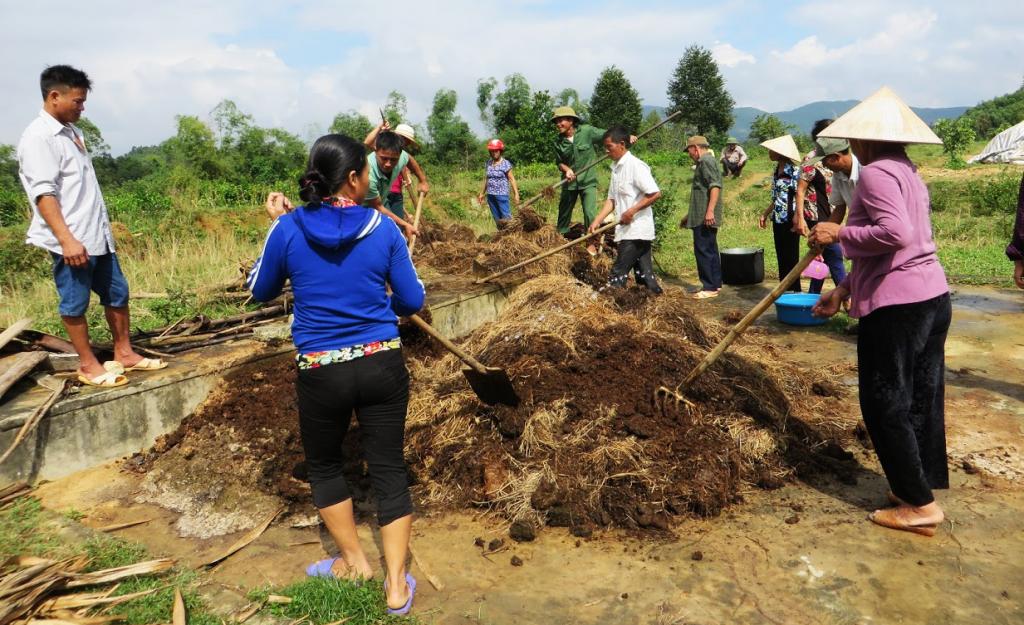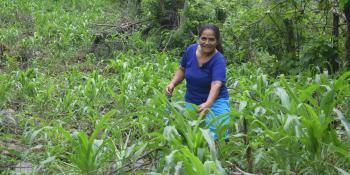Sharing her own climate-smart agriculture success story

A woman farmer from My Loi Climate-Smart Village in Vietnam shared with fellow farmers her experiences in adopting climate-smart agriculture practices, particularly organic composting.
It was the first time for Mrs. Le Thi Lien to stand in front of fifty fellow farmers and share how she makes organic compost. At the participatory scenario planning meeting held in Ky Son commune, Ky Anh district, Ha Tinh province in November 2017, she took the opportunity to explain how she prepares her own effective microorganism substance to speed up the decomposition of crop residues and livestock manure into an organic compost.
Mrs. Lien's family, like many other households in My Loi Climate-Smart Village (CSV), depends on crop cultivation and livestock raising for their livelihood. Currently, Mrs. Lien and her husband have about 100 chickens and seven cows, and own 1,000 sqm of grassland providing feed to the animals. In addition, the family cultivates 2,000 sqm of maize and 1,000 sqm of rice, and a small field of black pepper, in which vines are climbing on supporting trees, such as jackfruit, agarwood, and Mac trees (Wrightia annamensis).
Crop cultivation and livestock production are two complementary activities. Having raised cows since August 2015, Mrs. Lien was concerned about the livestock waste, specifically the large amount of dung and crop residues. Previously, she let the cow dung decompose naturally, or sometimes she added lime to kill bacteria and fungi. However, the process was slow and when she needed compost for immediate use, she had to utilize the not fully-decomposed compost. As dormant weeds, pests and diseases live in the dung, using young compost often resulted in weed, pest and disease infestations in her crops, like cutworms and crop root rot. Fresh manure can also corrode the root systems of crops and trees, and can cause a lot of damage. Uncovered and untreated manure not only smells bad, but runoff during rains may also contaminate waters and cause eutrophication.

In November 2016, Mrs. Lien had the opportunity to participate in a training course organised by the World Agroforestry Centre (ICRAF), together with the CGIAR Research Program on Climate Change, Agriculture and Food Security (CCAFS) in Southeast Asia, on composting using effective homemade micro-organisms. Mrs. Lien explained:
I joined the course because I knew it would help me in providing an easy-to-make, reliable compost that is cheap to produce and available whenever I need it.
Mrs. Lien started making effective micro-organisms back in November 2016 and continuously using the technology today. She produces effective microorganism three times a year that can generate at least three tons of compost annually. This organic fertiliser is used for rice, maize, beans, pepper, and vegetables. After adopting this climate-smart agriculture (CSA) practice, Mrs. Lien has experienced many advantages compared to the previous traditional method she was using. These include:
- properly decomposed compost;
- faster decomposition rate (20–30 days compared to 2–3 months);
- decreased pest and disease outbreaks, as they are eliminated through thorough composting;
- reduced weeds;
- healthier crops;
- less risk to human health;
- reduced environmental pollution compared to untreated compost;
- lower costs by using available resources, such as rice bran, to make effective micro-organism substance and cow dung and agricultural residues to produce compost; and
- easy and fast production (less than two hours to make one ton of compost).
A cost-benefit assessment also shows that the cost for producing one ton of effective microorganism compost only ranges between USD 2 and 4.
In addition to composting, Mrs. Lien also learned how to ferment feed for the cows using stems and leaves of crops like maize and peanut. She uses this as feed for her cattle during the cold and rainy seasons to strengthen the cows’ digestive system and capacity to resist the colder temperature.
Mrs. Lien, one of the pioneers in My Loi CSV, is very enthusiastic in trying and experimenting with the new technologies and CSA practices in her farm. Besides effective microorganism and fermented feed, she also invested in improving the cages for her goats, and tried using home-made bio-insecticides (a mixture of garlic, chilli, and alcohol) which control some pests eating crop leaves (i.e., vegetables, corn, and rice).
These are just some of the skills she learned from attending field visits organised by ICRAF under the CCAFS Southeast Asia project. From a regular participant, she is now the one sharing her experiences in using CSA practices, and this encourages other farmers to do the same.
Read more:
- Report: Village Baseline Study – Site Analysis Report for My Loi, Ky Anh district, Ha Tinh province – Viet Nam
- CCAFS blog: Creating wealth from waste: Worms are worth the investment
- CCAFS blog: Worms as nutrients for animals and soil
Le Thi Tam is a research assistant at the World Agroforestry Centre Vietnam.
Anoushka Carter is a science communication intern at the World Agroforestry Centre Vietnam.



